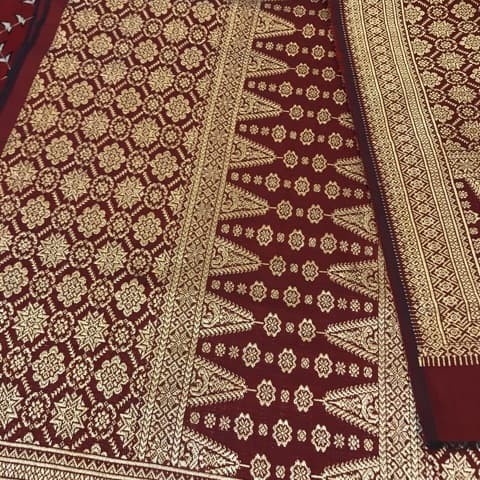Songket Lepus the Heritage Culture from Srivijaya Kingdom
INTRODUCTION
Sriwijaya Kingdom appeared in several inscriptions that founded around Sumatra island and Malaka straits. One of the inscriptions called Kedukan Bukit dated 16th June 682, stated that Swijaya as kingdom with Dapunta Hyang as the king. I-Tsing in 671 (Weerawardane:2009) stated that the Emperor was led by someone who has title as Dapunta Hyang. The other inscription is Kota Kapur inscription 686 M that described about the dominion of Sriwijaya in Bangka, Belitung & Lampung.
Sriwijaya named by China Kingdom as San-fo-tsi, Shih-li-fo-shih or San-fo-qi. Sriwijaya is powerful maritime kingdom, they had the strong army and special strategic of defense called Mandala.
As Mahayana Buddha’s kingdom and centre of monks pilgrimage Sriwijaya was rich with golds. Golds could be part of Sriwijaya art and culture. At that time money coin used gold, silver as their currency.
Palembang has been proven as the capital city of Sriwijaya by George Coedes in 1918. Palembang has strategic location and became the central of South East Asian trade and Monks’s stop over before India. Although the other historian, Pierre Yves Mangoin in 1933 declared that the center of the Kingdom was not Palembang, it was between Sabokingking Hill and Seguntang Hill near to Musi river. Soekmono the historian from Indonesia said that the capital city was Jambi. Another historian said that the centre of Kingdom was in Riau near to temple of Muara Takus.
The proof of multicultural relationship between Sriwijaya with another Kingdom is the named of Sriwijaya that given by other Kingdom. Khmer called Sriwijaya as Malayu. Arab call Sriwijaya as Zabaj. Ptolomeus as the founder of map of the world called Sriwijaya as Sabadeibei. The chamber and international relations happened in the Malay straits that managed by Sriwijaya Kingdom.
Sriwijaya has culture, proven by at that time people in Sriwijaya already used perfume on their body. The lifestyle already developed wines that made by flower, honey, fruit and coconut. People using Sanskrit language and Chinese letter for communication. People live in the city but some of them live in the suburd or near to the Musi river. The government already has taxation system but only for those who could afford to pay.
Since the Kingdom has richness in gold, the art and culture appeared in golden creation. The Sriwijaya people offered the Monks Gold Lotus flower. The richness of gold made them create a golden thread as Royalty symbol. Unfortunately, in that era, 7th-9th of century people in Sriwijaya has not been able to produce the golden thread. They send the gold to Thailand & China and ask them to make it as golden thread. In this stage, the multicultural has been developed. Sriwijaya kingdom citizen had been influenced by the culture of Thailand and China. Gold and silk in South East Asia Kingdom is the symbol of power (Maxwell:2014). Fine textiles one of the symbol of power and social stratification at that time in Kingdom Sriwijaya. Only King or Royalty family who could wear fine textiles which covered by gold. This fine textiles called songket in Palembang language. Songket has many variants according to the patterns. In this article Lepus songket is the primary data of research.
The fine textiles that made in Sriwijaya is songket, or some kingdom in South East Asia called them gold brocade. Songket came form the word, sungkit, to put gold thread in the upright of weaving cotton fabrics. The gold thread appeared in the surface of clothes and shining luxurious and beautiful. Songket crafted by hand made with special skills, through several steps in the making. This precious textile made in a several steps and need a long time, could be a couple months
The Songket Lepus is the most precious one and the first songket that ever made in the history of Palembang Songket. The Lepus created in the palace, by royalty family and made for the King and his family. The maker usually the girl that has not been married, while they waiting for the groom. King has special the experts who came from the royalty family and taught the princess and royalty family to make songket. This expertise was challenging since the one who make songket need to know the step and patiently do the delicate finishing. The process to make one songket around 8 months or more, depend on how complicated the patterns and how much threads would be applied.


